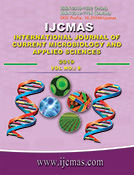


 National Academy of Agricultural Sciences (NAAS)
National Academy of Agricultural Sciences (NAAS)

|
PRINT ISSN : 2319-7692
Online ISSN : 2319-7706 Issues : 12 per year Publisher : Excellent Publishers Email : editorijcmas@gmail.com / submit@ijcmas.com Editor-in-chief: Dr.M.Prakash Index Copernicus ICV 2018: 95.39 NAAS RATING 2020: 5.38 |
Chickpea (Cicer arietinum L.), commonly known as garbanzo beans, are one of the most commonly consumed legumes in all over the world. Being one of the most nutritional elements of the human diet, chickpea contained various antinutritional compounds, including trypsin inhibitors, chymotrypsin inhibitors, phytic acid, tannin, condensed tannin and alpha amylase inhibitors which hampered the utilization of the nutrients by people. These antinutritional factors also hinder the in-vitro digestibility of both protein and starch. Hence, it is very necessary to eliminate these compounds and improving the in-vitro digestibility of both protein and starch so that these chickpea germplasms can be used as an alternative high valuable crop for the farmers and helps to provide health promoting food products in future. Food processing methods such as soaking, germination and roasting were quite popular to minimize these toxic substances. Based on the results, germination reduced only alpha amylase inhibitors (51.97%-53.53%) whereas roasting lowered trypsin inhibitors (62.16%-74.62%), chymotrypsin inhibitors (47.25%-56.02%), phytic acid (39.45%-46.66%), tannin (50.94% -61.01%) and condensed tannin (44.45%-47.95%). The improvement in in-vitro digestibility of both protein (3.63%-7.20%) and starch (20.29%-21.42%) were observed by roasting treatment. Considering all the processing methods attempted in the present study, roasting was the best method in improving the in vitro digestibility of protein and starch through lowering the antinutritional factors.
 |
 |
 |
 |
 |